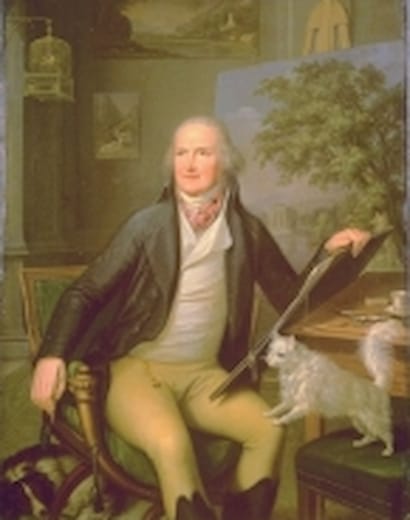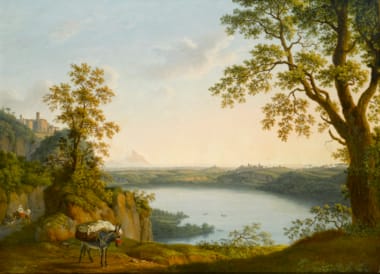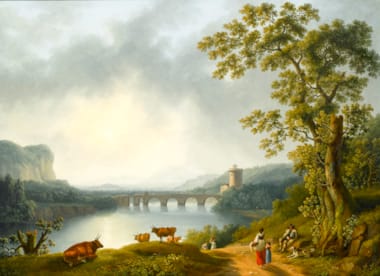
acob Philipp Hackert
(Prenzlau 1737 - San Pietro di Careggi 1807)
 Biography
Biography Lake Nemi from the North, with the Town of Nemi and the Town of Genzano beyond, with a Donkey and Travellers on a Path in the Foreground
Biography
Hackert studied first with his father, Philipp Hackert, then from 1755 with Blaise Nicolas Le Sueur at the Berlin Akademie. There he encountered, and copied, the landscapes of Dutch artists and of Claude Lorrain. The latter influence shows in two works exhibited in 1761, views of the Lake of Venus in the Berlin Zoological Garden (versions of 1764 in Stockholm, National Museum). These much admired paintings retain a rather rigid late Baroque style. Hackert’s main interest in these early works was to arrive at a special understanding of a place through alternate views, with reverse directions of observation. This systematic documentation bears witness to his interest in the study of nature.
In 1762 Hackert left Berlin for a study tour in northern Germany. He stopped in Stralsund and the nearby island of Rügen, where he was a guest of Adolph Friedrich von Olthoff, the Swedish councillor in Pomerania. The stimulus these travels provided is reflected in six landscapes in tempera (c. 1763; Potsdam, private collection), painted for the Olthoffs, and four frescoes (1763) in the great hall of Schloss Boldewitz. In May 1764 Hackert went from Stralsund to Stockholm with Baron von Olthoff, who presented him at court. In Sweden he produced a View of Karlsberg (1766; private collection) for the King and some drawings for the Queen. In the former all traces of decorative painting have disappeared, and Hackert gives a personal interpretation of the Dutch 17th-century painting and the work of Claude that he had copied. During this time he also produced a series of etchings, Vues de Suède, which shows his development, from rather perfunctory beginnings, into a remarkably evocative printmaker.
In 1765 Hackert went to Hamburg, and from there to Paris, where there was a growing interest in the kind of landscape developed by Dutch painters. He modelled his work closely on the work of the most famous exponent of this genre, Jean-Claude Wille, and his small landscape gouaches, well suited to contemporary taste, brought him renown. This enabled him in 1768 to depart for Italy. After visiting Livorno, Pisa and Florence, he arrived at Rome, where he remained until 1786. During this period the colonies of French, German and English artists and scholars in Rome were growing more and more numerous. Hackert brought to the German group, headed by Anton Raphael Mengs and Johann Joachim Winckelmann, an already rich and complex cultural experience. He upheld his classical formula of landscape through sketches made on study tours (to Sicily in 1777, to Switzerland in 1778), through oil paintings and through such prints as the four Views Sketched in the Kingdom of Naples (1779; Naples, Capodimonte), which mark a new independence for engraving as a medium for landscape.
In 1782 Hackert met King Ferdinand IV of Naples, and in 1786 he settled in Naples as court painter. During his 13 years in the city he consolidated his European fame, largely through the advocacy of Goethe, whom he met in 1787 and who became his close friend. He also started his own school, propounding his ideas about landscape painting to engravers, including his brother Georg Hackert and W. G. Gmelin (c. 1760–1820), and such painters as Christopher Kniep (1755–1825), Michael Wutki (1738–1822), and the Neapolitans Vincenzo Aloja ( fl 1790–1815) and Salvatore Fergola (1799–1874). Perhaps Hackert’s finest Neapolitan works were the Four Seasons, luminous Neapolitan vedute enlivened by figures in local dress. The originals, intended for King Ferdinand’s hunting-lodge on Lake Fusaro, were destroyed by 1799, but smaller copies by Hackert survive (Spring, Switzerland, private collection; Summer, Winter, Nuremberg, Germany National Museum; Autumn, Cologne, Wallraf-Richartz Museum). Hackert’s intellectual interests can be seen among the pictures (1792–3) painted for Queen Maria Carolina’s bathroom in the Belvedere di S Leucio near Caserta. Some of these use the old encaustic technique and are inspired by objects that came to light during the archaeological excavations at Herculaneum. Hackert did not merely evoke the Antique; he re-lived the tradition in his own personal way, again confirming his acuteness in interpreting the most recent cultural trends of his time. Another work painted at S Leucio, the Harvest Festival (1782; Caserta, Palazzo Reale) is a fine example of his idyllic interpretation of the landscape around him.
When the Revolution of 1799 forced him to leave Naples, Hackert settled permanently at San Pietro di Careggi, near Florence. Here he returned to his old interest in nature with renewed perception, in fact becoming a sort of proto-Romantic landscape artist. After his death his memoirs were edited and published by Goethe.












